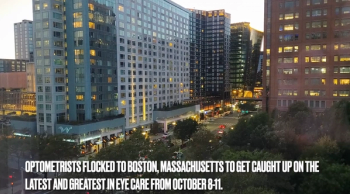
SECO 2023: Glaucoma treatments in the optometrist's wheelhouse
Nate Lighthizer, OD, gives highlights from his SECO 2023 presentation, "The glaucoma compass."
Nate Lighthizer, OD, shares keytakeaways from his presentation titled, "The glaucoma compass," which he presented during the 2023 SECO meeting held this year in Atlanta, Georgia.
Editor's note: This transcript has been edited for clarity.
Lighthizer:
We're discussing here at SECO in Atlanta, the "Glaucoma Compass." Looking forward to that lecture, where we talk on glaucoma and all of the different things that can be involved in glaucoma.
Glaucoma is truly a puzzle. We have no perfect test for glaucoma. There's not one thing that we can do that says you have glaucoma or you don't have glaucoma, or you are progressing or you are stable. We add up a variety of things that we can do, and this is both from a diagnostic perspective, as well as a therapeutic perspective.
From a diagnostic perspective, all the tests that we can do like visual fields, OCT, we have got IOP, we do central corneal thickness, we take a look at corneal hysteresis, and that's not even adding in things like ERGs (electro retina grams), OCT, angiography fundus photos, there's a whole wide variety of testing that we can do to help determine, "Does this patient have glaucoma, or do they not have glaucoma?"
We're going to go through a case based series in this lecture to help drive home those different points. Sometimes it's the visual field, sometimes it's the OCT. Sometimes it's a combination of all of those plus the IOP corneal hysteresis that really helped us to pull the trigger one way or the other.
How often have you been on the fence in glaucoma? We've all been there where you go, "Oh, man, the testing, I'm adding it all up and maybe it's glaucoma, maybe it's not." Fortunately, we often have time to get further testing, get additional data, bring them back and repeat that testing. We'll cover all of that in this lecture from the diagnostic perspective.
And then we'll switch to the therapeutic perspective. We've got lots of options in glaucoma. We've got wonderful eyedrops, and more and more eyedrops coming out things like VYZULTA, Rocklatan, Rhopressa have come out in the last 3 to 5 years that add to the traditional prostaglandin analogs, your Travoprost, XALATAN, things like that. So we've got drops, and we've now got drug delivery devices. We'll briefly talk on DURYSTA, which is an intracameral implant of latanoprost into the anterior chamber that has been shown to have effectiveness for anywhere from 4 months even up to 12 months and longer, which it can reduce that burden for patients of putting an eyedrops.
So between drops, drug delivery, SLT, which we've covered in other lectures with the laser therapy. SLT is a first-line therapy and then don't forget MIGS, as well. So it's really a mixing and matching.
Gone are the days of drop one, drop two, drop three, drop four, then we consider surgery or laser down the road. The mindset of interventional glaucoma, meaning we may go SLT earlier to keep them off of drops, they may need to drop mixed in here or there. It's time for cataract surgery and they can have cataract surgery or one of these wonderful MIGS devices. There's just a lot of different things that we can mix and match at different stages of disease that help patients in glaucoma.
So that's the therapeutic perspective, kind of on the back end, the diagnostic perspective on the front end, I think some of the key points are going to be that it's okay to be unsure in glaucoma, because we don't have a firm answer much of the time.
A good answer in glaucoma is "it depends; maybe." You know, and you have time to see them back in three or four months to repeat testing. And it's okay to be a little bit uncomfortable because many of our ophthalmology colleagues, they're on the fence and they're going back and forth as well. So it's okay to get more testing and it's okay to be, "you know what, I'm going to try this treatment for a little bit." It's not working for the patient, let's try an SLT, let's try a different drop. It's okay to be a little bit uncomfortable in glaucoma because it depends much of the time.
I encourage ODs everywhere that glaucoma is in optometry's wheelhouse to jump on board and managing glaucoma. We've got a plethora of diagnostic tests and a wonderful array of therapeutic options now—drops tried and true, but a lot of new emerging treatments or established treatments like SLT.
So jump in and manage glaucoma and it'll be very rewarding for you and your patients.
Newsletter
Want more insights like this? Subscribe to Optometry Times and get clinical pearls and practice tips delivered straight to your inbox.



















































.png)


